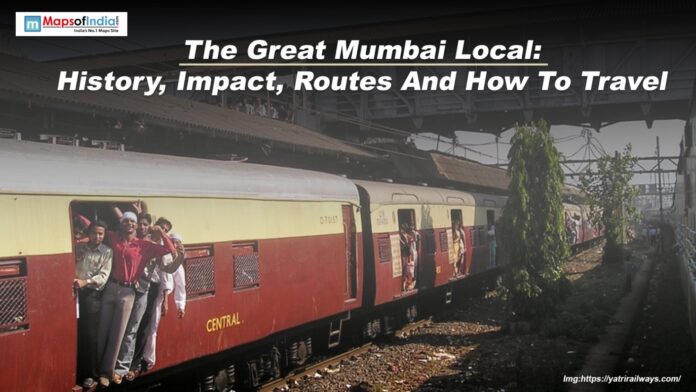We all know the city of Mumbai as the ‘City of Dreams’. It is a sprawling city renowned for its hustling life and cultural diversity. In the heart of this city, we find the local train system in Mumbai, which is spread across the city. This system ferries millions into work daily and hence is called the ‘Lifeline of Mumbai’. Through this article, we shall know the history of this transport system. The impact, routes available, and how to travel if you are a beginner.
History
The railway network in the city of Mumbai was inaugurated on April 16th, 1853. The train ran between the stations of Bori Bunder and Thane. It covered a distance of 34 kilometres in 1 hour, 15 minutes. This train ran as a test to assess the viability of the idea. But who knew that it would become so popular? However, this was the country’s first train. It wasn’t the local train. But this led to train networks connecting the city to facilitate trade and transport.
The train became popular among the city dwellers, and they demanded connections across the city. The first local train ran in the early 1900s and became known as EMUs (Electric Multiple Units). With the local parlance, the word Mumbai local found its place in the hearts of the residents. Today, the first rail network to be constructed is the Central Line. Eventually, the entire city of Mumbai grew in all directions, as did the local network. Currently, the network has the Western Line, Central Line, Harbour Line, and smaller networks connecting different areas.
Impact
The Mumbai local is not merely a mode of transportation. It is an essential feature of the socioeconomic fabric of the city. Since the train is spread all across the city, it helps different people reach their respective destinations. Doesn’t matter if you are a student, office employee, advocate, doctor, etc.; you can rely on this system to reach your destination quickly.
The train carries millions of people every day to and from their destinations. The local’s USP is the price. It is accessible to people from all walks of life. Moreover, the presence of a local train station facilitates the flourishment of economic activities in an area. Food stalls, retail stores, and service providers are around and in the station, serving the high foot traffic in these areas.
The local train is an excellent alternative to private vehicles. This is crucial in decongesting the congestion on roads and reducing pollution levels. It additionally ensures lower pollution levels in the city.
Routes of the train
Almost 7.5 million people commute using local trains in Mumbai in one day. The railways run more than 2300 services daily that ferry the commuters. There are more than 100 stations all over the city. The railways have divided the city into two zones: Western Railway (WR) and Central Railway (CR).
In these zones, the entire city is divided into three ”lines’—Central, Western, and Harbour.
Central Line
The central line of the Mumbai local originates from the famous Chhatrapati Shivaji Maharaj Terminus (CSMT) and passes through the stations of Dadar, Matunga, Sion, Kurla, Vidyavihar, and Thane, among others, finally concluding at Kasara or Khopoli. Then, the trains return from Kasara or Khopoli, pass through the same stations, and return to CST. This process is repeated countless times throughout the day. The total journey time between this route’s first and last station is approximately 2.5 hours.
On this route, both AC and non-AC locals are available for commuters. However, there is a major price difference between AC and non-AC.
Western Line
The western line of the Mumbai local originates from the Churchgate station and goes up to Borivali, passing through Marine Lines, Dadar, Mahim, and Bandra before concluding at Dahanu Road. The train then returns from Dahanu Road back to Churchgate, ferrying the passengers. On this route, the journey takes 2 hours to cover the entire route.
On this route as well, AC and non-AC locals are available. Commuters can choose them at their convenience.
Harbour Line
The harbour line of the Mumbai local originates from CSMT and concludes at Panvel in Navi Mumbai, crossing Kurla, Mankhurd, Vashi, and Seawoods, among other stations. This route is fairly new compared to other routes and takes 1 hour and 20 minutes to complete.
Only non-AC locals are available on this route, and the railways have not yet introduced AC.
How to Travel: A Beginner’s Guide
Let’s say you are new to Mumbai and want to explore the city by train, but you cannot understand what and how questions about train travel. So, to simplify these questions, this article also provides simple steps regarding travelling with the locals.
What to do?
If you want to travel by local train, download the M-Indicator app from the Play Store or the App Store. The app provides a comprehensive guide regarding the available routes, the timings of the trains, platform numbers, and how to change trains in case you have to change lines.
As soon as you open the app, on the top left corner, you will find the ‘Local’ option along with the logo. Upon clicking it, you will enter the next page, where you can see a list of stations. If you want to find out what time the train arrives at your station, just search for it, and when you click it, you can see the train’s arrival, final destination, and platform number.
Then, if this option is confusing for you, you look for the ‘A to B’ option located at the top and middle of the screen. Select it and from there you can directly search for your station and destination. It will tell you all the details.
After this, purchasing a ticket is the next important thing to do while travelling. Because travelling without a ticket is a punishable offence. So, you have two options: a physical or digital ticket. Physical tickets can be bought from the counters available at the stations’ entrance. The ticket prices are between Rs. 5 and Rs. 40 (approx. rate for one-way journey for non-AC; the rates for AC differ). Digital tickets can be availed from the UTS app, also available on the App Store and Play Store. You can purchase daily tickets and/or seasonal passes for all AC or non-AC locals on that app. However, make sure you buy your tickets before reaching the station because sometimes this facility does not work near and in the stations.
How to go?
Upon purchasing the ticket and locating the platform, you reach the platform. Like usual railway stations, you will find boards showing the train timings. However, the difference between normal and local stations is that the local stations have some additional information.
Firstly, the board will provide the train time. Then, it will give the final destination of the train. After that, the board will display the letters ‘S’ or ‘F’. The former denotes slow, meaning the train will stop at every destination between here and the final station. The latter denoted fast, meaning the train will only stop at selective stations. So, depending on the time you have and your destination, you can decide which train to board. This information is available on M-indicator as well.
However, if you still cannot figure anything out, ask anyone on the platform. People are really helpful and will always guide you correctly. So when the train comes, board the train and enjoy the journey to your destination. However, on weekdays, the enjoying part may not seem so accurate due to the heavy rush, but other than that, you will reach your destination fast and in an affordable manner.




